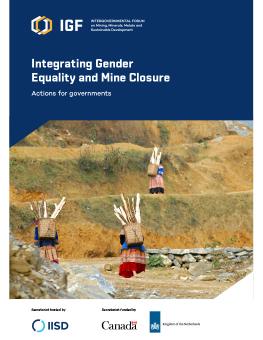
Integrating Gender Equality and Mine Closure: Actions for governments
Report on how mine closure and gender equality intersect and how governments can ensure closure practices and policies integrate gender considerations.
Mine closure is an essential component of developing, operating, and closing a mining operation. Proper mine closure planning ensures that the mine site is safe, stable, and environmentally sound, and mining communities are economically and socially sustainable in the post-mining transition. Gender equality is also an essential element of mining across the entire life cycle, including mine closure. Women in mining communities often experience unequal and negative impacts from mining and, at the same time, do not benefit equally from opportunities, such as employment and community support. As such, their experience with mine closure can be expected to be different than men’s.
However, the social impacts of mine closure on women—and the interconnectedness of gender equality and mine closure—are often insufficiently considered. A limited number of studies from South Africa, sub-Saharan Africa, and Canada have identified a strong correlation between mine closure and women’s social, economic, and domestic vulnerability. The research shows that the outmigration of the male population to find livelihoods elsewhere and the social upheaval that comes with loss of employment and decreased economic activity are triggers for these impacts. The consequences can include increased crime rates, prostitution, poor nutrition, lack of food security, and heavier domestic and care responsibilities. The decline in the economic and social well-being of women can increase if the impacts of mine closure are not adequately considered.
This report addresses the interconnectedness of gender equality and mine closure by reviewing current issues and practices in both mine closure and gender equality—and, importantly, where they intersect—and provides policy recommendations for governments to ensure that gender considerations are integrated into all aspects of mine closure. The report explores how to implement processes that assess and respond to the interests of the entire community, including the following:
- gender-based analysis and intersectionality
- community engagement approaches
- post-mining land-use decisions
- transitioning mine workers and those in the service and supply sector
- community, social, and economic support for closure and the post-mining transition
While most of the work to plan and implement mine closure is the responsibility of the mine operator, governments have an important role in setting regulations, standards, and guidance on how that closure work should be undertaken. As an overarching recommendation, governments should develop a gender mining strategy that addresses the concerns of women and men and takes an intersectional approach.
Participating experts
You might also be interested in
IGF Case Study: Leveraging Technologies for Gender Equality in Mining Communities
How can sharing technological infrastructure support gender equality and serve the broad betterment of mining communities?
Parental Leave Policies in the Mining Sector
An in-depth look at international and national parental leave frameworks and policies across 12 countries.
Gender Impact Assessments: Breaking the pattern of inaction
Report outlining an event focused on how diverse stakeholders can support gender impact assessments for mining.
Women and the Mine of the Future
Uncovering the gender-disaggregated employment profile for large-scale mining, focusing on women and their occupations in 12 countries.